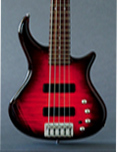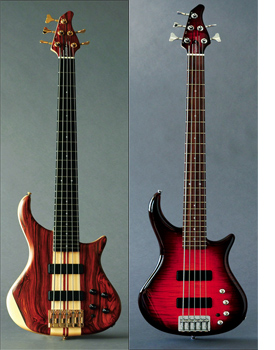Pedulla Thunderbolt TB-5 and TB-5 19mm 5 string basses


BACK IN THE LATE SIXTIES, when cigarettes were still being advertised on TV, the Chesterfield brand introduced a new line of smokes called 101s, which were 101 millimeters long. The whole marketing concept behind the brand was to poke fun at competitor Benson & Hedges, which had just introduced Benson & Hedges 100s, and the Chesterfield ads brilliantly skewered B&H's obsession with size by pointing out their cigarettes were "a silly millimeter longer" (which was sung to the tune of "La Bamba").
That old jingle came to mind when I first heard about Pedulla's Thunderbolt TB-5 19mm, the wider-necked version of the Thunderbolt TB-5. The 19mm reference comes from the string spacing at the bridge (19mm is approximately 3/4"). That makes the added width at the 22nd fret a bit more than Chesterfield's millimeter. To be exact: 6.35mm (approximately 1/4"). How much difference could a quarterinch make? You'd be surprised. Despite its bold moniker, the Thunderbolt is a bass of great subtlety, where seemingly small details can make a big sonic difference.
HEAVY NECKING
Pedulla's Thunderbolt basses are cousins of the company's Thunderbass line. They have a similar body shape, use the same active Bartolini soapbar pickups and TBT preamp, and also employ Pedulla's unique tone-shaping Thunderguts switch. Where the two diverge is at the neck: the Thunderbass is neck-through, whereas the Thunderbolt is bolt-on (Thunderbolt, get it?).
Pedulla sent the two Thunderbolt 5-string models for our tests, and the pair nicely showcased the strengths and aesthetic possibilities of these basses. Both were, of course, gorgeous- Pedulla is justifiably famous for the quality and beauty of its woods and finishes-and both played like butter and felt like old friends right out of the box, no adjustments needed.
The TB-5 (the one with the standard- sized neck) has a captivating AAA flame maple top finished in a rich "vintage cherry sunburst" and highlighted by the contrasting rosewood fingerboard and chrome hardware. Its wider sister is an ETB-5 19mm, with the "ET" standing for "Exotic Top," in this case, deep coffee-colored Bubinga wood. This bass also sports a coated maple fingerboard and gold hardware. Otherwise, the two were identical, with 34- inch-scale hard maple necks, soft maple backs, brass barrel bridges, identical Bartolini pickups and the four-knob control arrangement, and the same Thunderguts switch. Let's call them Skinny Red and Big Bubinga.
Being attracted to bright, shiny things, I started with Skinny Red. At just under ten pounds, it was hardly a featherweight, but was so well balanced and shaped that I barely noticed the load once it was strapped on. Also, the contour of the upper half of the body lets the bass slip into the ideal playing position, snug against the body but angled out enough for optimal access to the strings.
Each pickup is positioned in a carefully chosen spot, both for tone and comfort. When using the neck pickup as a thumb rest, my fingers fell into a naturally bright sweet spot about four inches from the bridge. There's also plenty of room between the pickup and the neck for slapping, and the comfortably wide string spacing was no doubt beneficial to my occasionally sloppy thumb.
Get The Pick Newsletter
All the latest guitar news, interviews, lessons, reviews, deals and more, direct to your inbox!
But as happy as my right hand was, it had nothing on the left. Pedulla has one of the best-shaped necks in the business-thin but carefully contoured, it delivers both the ease and speed of a J-Bass neck, while also suggesting the solidity of a P-Bass. Playability can best be described as effortless, whether you're playing low and funky or high and melodic.
Being so pleased with Skinny Red, I didn't give much thought to Big Bubinga, until I decided to take Red to a rehearsal while using Bubinga for the gig. It turned out to make for a telling comparison. For one tune, I was asked to cover a cello part, which meant working between the 8th and 18th fret while trying to create the illusion of smooth legato phrasing without a bow.
Things worked well enough with Skinny Red, although the part sounded a little, well, thin. On the gig with Big Bubinga, by contrast, what had initially seemed a chore suddenly became a pleasure. Thanks to the extra distance between strings, I had more room to play with vibrato, while the maple fingerboard added enough edge to the tone to make the sustain seem more expressive and less guitar-like than before. It wasn't quite like playing arco, but it was plenty close.
It isn't just the string spacing that makes Big Bubinga so comfortable in the upper register. Pedulla uses a different fingerboard radius for standard five-strings like Skinny Red and for 19mm five-strings like Big Bubinga (a 12-inch radius for the former, a 15-inch for the latter). What that means in practical terms is that Big Bubinga's fingerboard is slightly flatter. Combined with the additional width, it improved my left-hand positioning, and made it easier to focus on controlling the strings.
It was a fairly subtle improvement, but Pedulla has a flair for subtlety. Take, for example, what the electronics and pickups do with the tone. Both basses have an inherently warm, midrange-y sound, with crisply defined and clearly present highs, and a tight, punchy low end. With the Thunderguts switch on, the mids and upper lows take on added weight and richness, as if you'd just gone from chocolate to chocolate fudge. And with the well-voiced, simple, and powerful Bartolini TBT bass and treble cut/boost controls, it's easy to fine-tune and reshape either instrument's sound to suit just about any situation.
But the controls are just the beginning. Because the active circuitry and Bartolini pickups are exceptionally transparent, they don't add color so much as amplify the basic characteristics of the Thunderbolts' sound, and where that really pays off is in your right hand. If you tend to use a variety of picking techniques, or even just greatly vary the intensity and dynamics of your attack, these basses have an uncanny way of enhancing such nuances that makes those subtle shadings seem even more remarkable and vivid.
And it only gets better the louder you play (unlike some basses that turn to mush at high volume). Both Thunderbolts sounded great at moderate volume through my Gallien-Krueger 400RB-IV and 210; on my test gigs, Skinny Red showed a few more teeth with a bit more growl, while Big Bubinga's sustain and warmth were wonderfully consistent in all registers. Big Bubinga's maple fingerboard made it a bit better for slapping, with plenty of clank-free bite, while Skinny Red sounded more at home in fingerstyle situations. And when I played both basses through a cranked G-K 800RB with a SWR Goliath III 4x10, the difference was like seeing a movie on DVD or seeing it in the theater: The story stayed the same, but the delivery offered more attentiongrabbing presence and detail, with obviously greater impact.
THE BOTTOM LINE
With a list price of over three grand, neither version of the Thunderbolt is cheap, but even so, Pedulla definitely delivers value. In addition to looks that will leave your bandmates drooling, these basses are clearly designed and built with a craftsman's sense of pride, and painstaking, unsurpassed attention to detail. And while they have plenty of power, their real strength is their ability to convey a wide range of shading and nuance, which is evident when playing quietly or solo- and also when blasting at high volume. And if you spend a lot of time high up on the neck, or you're a wild-ass slapper, definitely go for the 19mm option. There's nothing silly about a few extra millimeters
“An esoteric boutique vibe, superb ergonomics and a powerful, unique preamp – Tobias is back”: Tobias Growler IV review
“Affordable versions of the three best basses I've ever held in my hands”: Sterling by Music Man completes its trilogy of Joe Dart signature models with a trio of made-to-order basses that cost less than $500










